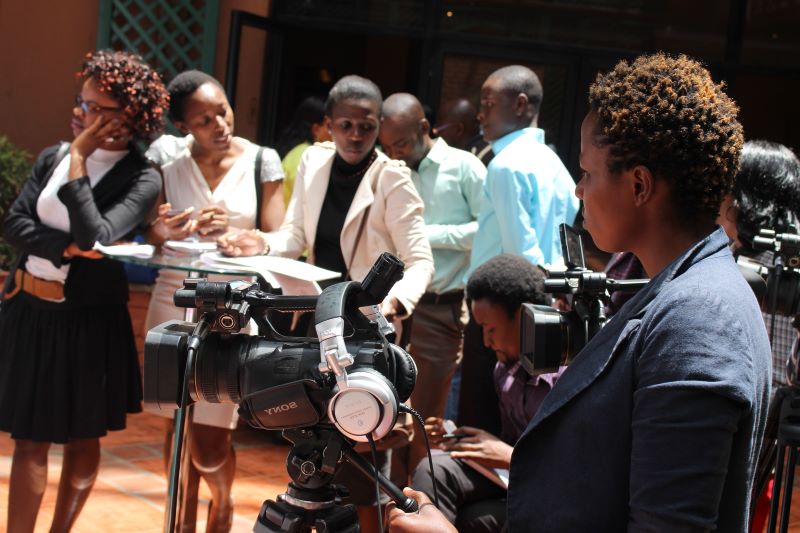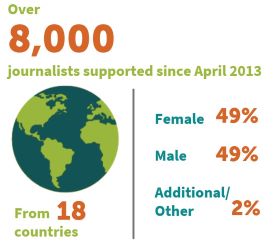The success of SAFE: 10 years and more than 8 thousand media workers

The journalism profession has grown increasingly dangerous, with journalists citing threats, arrests, censorship, and even death as the risks they face. In 2022, the Committee to Protect Journalists reported a record breaking 363 journalists imprisoned, and at least 67 killed. Since 2013, IREX’s Securing Access to Free Expression (SAFE) initiative has sought to keep journalists safe by equipping media professionals and social communicators with tools and resources to mitigate risks and respond to threats.
For ten years, SAFE has supported more than 8,000 media professionals across 18 countries by hosting trainings and workshops, providing psychosocial support, anonymizing their online presences, and fostering communities to advocate for and support independent journalism. SAFE participants have been on the frontlines of wars, elections, natural disasters, and the COVID-19 pandemic. However, only 27% of participants attended a safety training prior to SAFE – a clear indication of the need for this type of support.
Helping journalists mitigate risks
 Surveys show that SAFE participants have successfully implemented the tools and strategies from the trainings. Ninety percent of participants who faced a safety challenge following SAFE’s training reported that the knowledge and skills from the training was “very helpful” or “extremely helpful” in addressing the situation.
Surveys show that SAFE participants have successfully implemented the tools and strategies from the trainings. Ninety percent of participants who faced a safety challenge following SAFE’s training reported that the knowledge and skills from the training was “very helpful” or “extremely helpful” in addressing the situation.
Adapting to evolving challenges
Over the years, the SAFE initiative evolved to remain relevant to today’s media professionals and social communicators by adapting and updating its resources, tools, and materials to protect participating journalists from new and evolving risks they face while performing their duties.
At the height of the COVID-19 pandemic, when a sizeable portion of the population were working socially distant, journalists continued personal engagement to keep the public informed. To support their efforts, SAFE added COVID-19 mitigation techniques and protocols to its training materials. SAFE also offered remote trainings and published a risk assessment which shared information on how journalists were impacted by COVID-19, recommendations to continue their work safely, and potential opportunities to seize. One such opportunity was how the focus on the online sector of media allows for new voices, especially from marginalized communities, to be heard.
SAFE also addressed the challenges journalists face when covering events with inherent dangers. For example, SAFE created materials on election-related violence and held election-focused trainings to provide journalists with the knowledge and approaches to navigate conflict if it arose. Further with climate change increasingly leading to extreme weather conditions, SAFE worked to promote awareness of additional risks faced by environmental-focused journalists and activists.
Following SAFE trainings, 95% of participants reported that they had stayed in their profession, and 63% of participants reported that their organization had implemented new or updated safety procedures and protocols. One SAFE participant reflected, “This training was extremely timely and eye opening! All people need to have this knowledge. It is lifesaving!”
Prioritizing meaningful inclusion
At the core of SAFE’s work is IREX’s Do No (More) Harm approach. With women, gender non-conforming individuals, people from rural communities, and ethnic minorities often disproportionately affected by safety risks, SAFE prioritized these groups by ensuring training materials and resources are accessible and address identity-based risks. Specifically, SAFE developed the Inclusion Annex to the SAFE Basic Training Curriculum, which outlines SAFE’s approach and methodology for ensuring equal access to its trainings, addressing identity-based risks, and challenging harmful norms and stereotypes. SAFE also created an internal Equal Access Policy to reduce the obstacles participants might face such as dependent care costs.
Looking to the future of SAFE
As new laws and policies restricting freedom of press and expression become more prevalent, SAFE will continue to dedicate resources to learning, innovation, and evolution to provide up-to-date, holistic journalist safety trainings. It is critical that this work continue until every journalist and activist can manage the physical, digital, and psychosocial risks and threats they face.